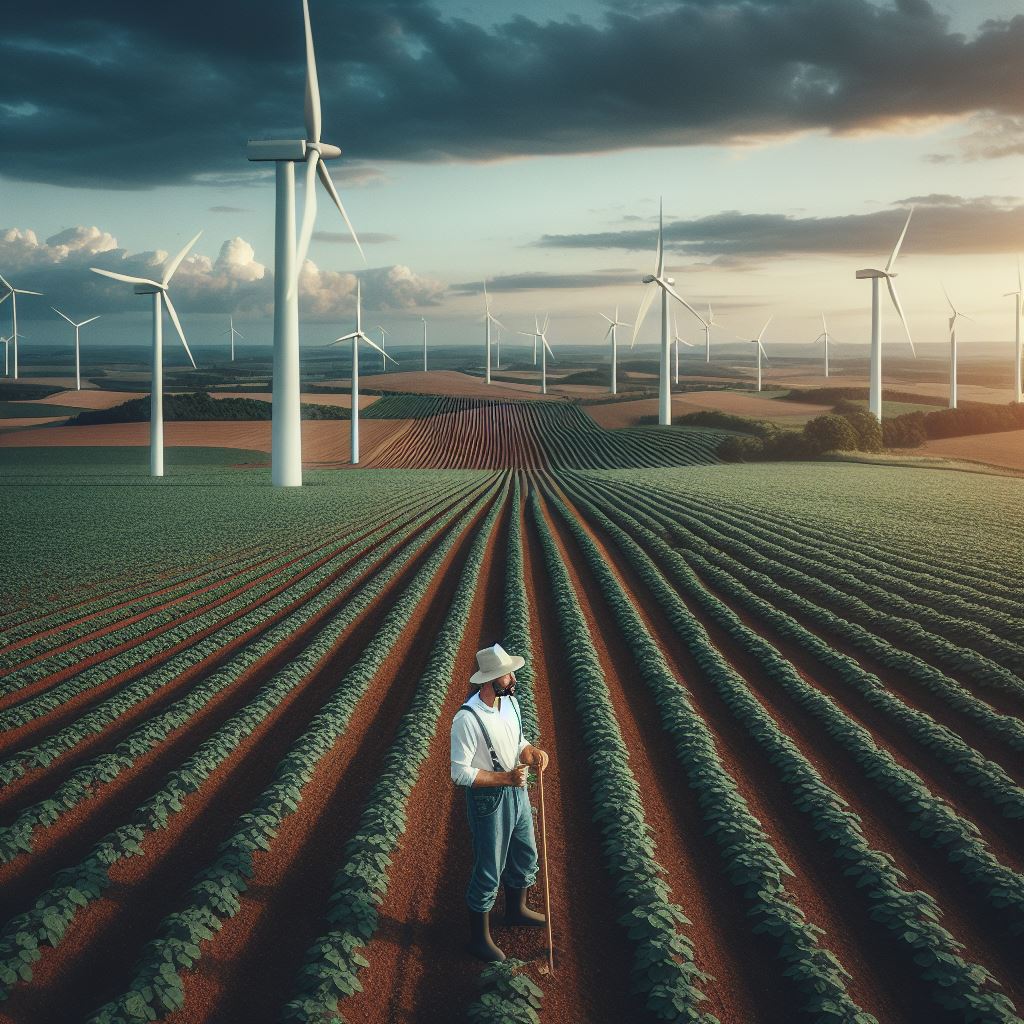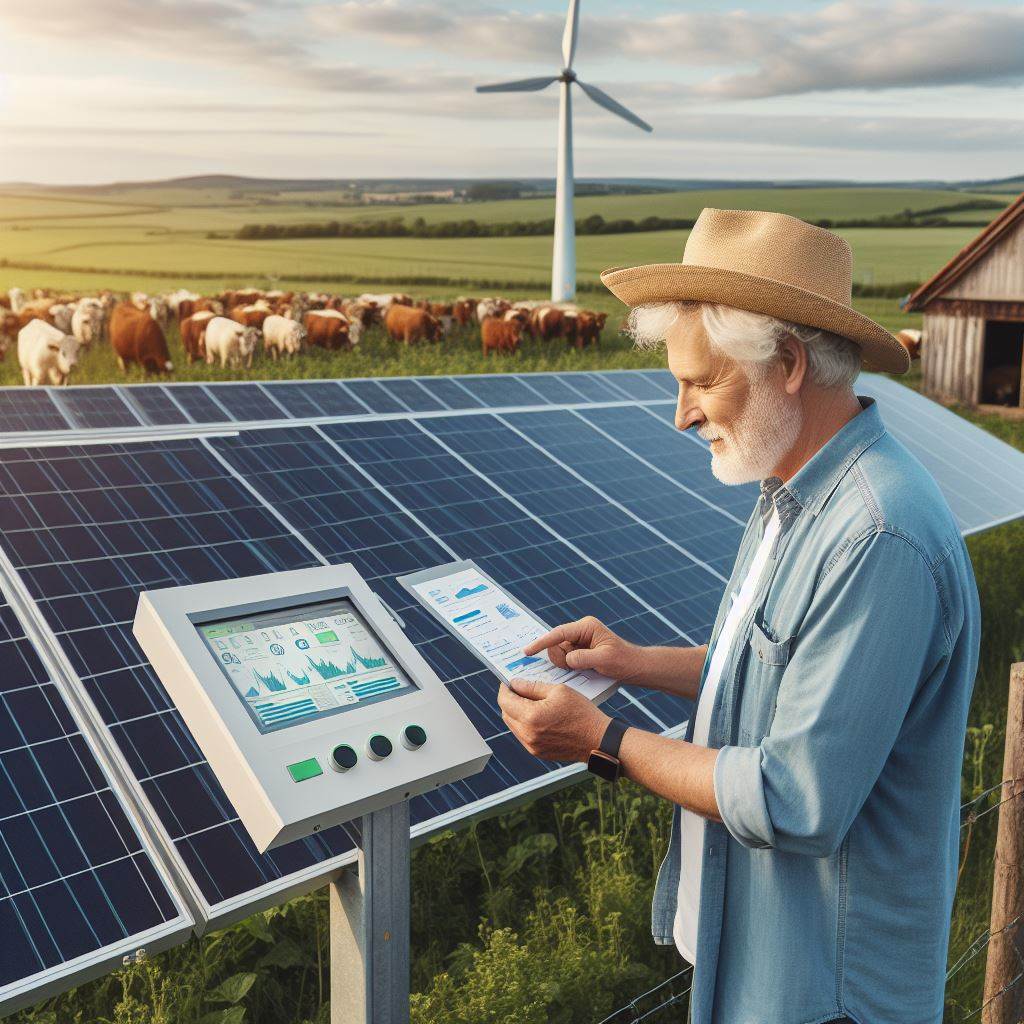Introduction
Sustainable farming practices are crucial for preserving the environment and ensuring long-term food production.
Wind is a natural and abundant resource that can be harnessed to generate clean and renewable energy for farming.
Harnessing wind power offers numerous benefits for sustainable farming.
- Energy production: Wind turbines can generate electricity to power various farm operations, reducing reliance on fossil fuels.
- Cost savings: By offsetting electricity costs, farmers can save money in the long run, making their operations more economically viable.
- Environmental impact: Wind power produces zero greenhouse gas emissions, helping to combat climate change and improve air quality.
- Water conservation: Wind turbines use minimal water compared to other energy sources like coal or natural gas, making it a sustainable choice for farming.
- Resilience to climate change: Wind power is less vulnerable to the unpredictability of weather conditions, providing farmers with a reliable source of energy.
- Job creation: The wind industry offers opportunities for local jobs, contributing to rural economic growth and supporting sustainable farming communities.
In short, harnessing wind power in sustainable farming is an effective way to reduce environmental impact, save costs, and promote long-term agricultural viability.
By embracing renewable energy sources, farmers can contribute to a greener planet while ensuring the sustainability of their own operations.
Benefits of harnessing wind power in sustainable farming
Decreased reliance on non-renewable energy sources
- Wind power provides a clean and renewable source of energy for farming operations.
- By harnessing wind, farmers can reduce their reliance on fossil fuels and decrease their carbon emissions.
- Using wind turbines, farmers can generate electricity to power their equipment and facilities.
- This reduces the need to rely on non-renewable energy sources, like coal or natural gas.
- By switching to wind power, farmers can contribute to a more sustainable energy future.
Cost savings and potential for income generation
- Investing in wind power can lead to significant cost savings for farmers.
- Once wind turbines are installed, they require minimal maintenance and have low operating costs.
- Harvesting wind energy can help farmers reduce their electricity bills and save money in the long run.
- In addition to cost savings, farmers can also generate income by selling excess electricity back to the grid.
- By becoming energy producers, farmers can tap into a new revenue stream while reducing their expenses.
Reduced carbon footprint and environmental impact
- Harnessing wind power contributes to a significant reduction in carbon footprint.
- Fossil fuel-based energy production releases large amounts of greenhouse gases into the atmosphere.
- By relying on wind energy, farmers can actively reduce their environmental impact and combat climate change.
- Wind power is a clean and renewable energy source that produces zero emissions during operation.
- Choosing wind over non-renewable energy sources helps protect ecosystems and promotes sustainability.
By embracing wind power, sustainable farmers reap multiple benefits.
They lessen their dependence on non-renewable energy sources, lowering their carbon emissions in the process.
Furthermore, utilizing wind turbines for electricity production brings about cost savings and potential income generation.
Additionally, harnessing wind power significantly reduces the carbon footprint and environmental impact associated with traditional energy production.
With these advantages, sustainable farming practices and wind power go hand in hand.
Read: Eco-Friendly Farms with Solar Tech
Wind power applications in sustainable farming
Irrigation systems powered by wind
Wind power has proven to be a valuable resource for sustainable farming, especially when it comes to powering irrigation systems.
By harnessing the power of the wind, farmers can benefit from several advantages:
- Efficiency: Wind-powered irrigation systems can efficiently distribute water to crops, ensuring optimal growth and productivity.
- Cost savings: Using wind energy to power irrigation reduces reliance on fossil fuels, resulting in significant cost savings for farmers.
- Environmental friendliness: Wind power is a clean and renewable energy source, reducing greenhouse gas emissions and environmental impact.
- Reliability: Wind is a consistent resource, especially in open farmlands, providing a reliable source of energy for irrigation.
Several successful examples of wind-powered irrigation systems exist worldwide:
- In California, the Shiloh Wind Power Plant provides electricity to power irrigation systems for farms in the region.
- The Danish Wind Power Company has developed wind-powered pumps specifically designed for agricultural irrigation, resulting in reduced energy costs for farmers.
- In Australia, wind-powered irrigation has been utilized in dry regions to enhance crop production during water scarcity.
Wind turbines for on-farm electricity generation
Alongside irrigation, wind turbines can also generate on-farm electricity, offering numerous benefits:
Transform Your Agribusiness
Unlock your farm's potential with expert advice tailored to your needs. Get actionable steps that drive real results.
Get Started- Energy independence: By installing wind turbines, farmers can generate their own electricity and reduce reliance on the grid.
- Cost savings: On-farm electricity generation through wind turbines can result in significant savings on electricity bills.
- Long-term investment: Wind turbines have a lifespan of 20-25 years, providing a reliable and sustainable source of energy for farmers.
- Environmental sustainability: Wind power is a green energy solution that helps reduce dependence on fossil fuels and lowers carbon emissions.
However, selecting the appropriate turbine size and capacity is crucial for optimal energy generation:
- Wind resources: Assessing wind patterns and speeds on the farm helps determine the suitable turbine size.
- Electricity demand: Evaluating the farm’s electricity needs helps determine the appropriate turbine capacity.
- Budget considerations: Balancing the initial investment with long-term energy production and savings is essential.
- Space availability: Availability of sufficient space on the farm determines the size and number of turbines that can be installed.
Windbreaks and benefits for crop protection
Windbreaks play a vital role in sustainable farming practices, offering several benefits for crop protection:
- Wind reduction: Windbreaks act as barriers, reducing wind speeds and minimizing crop damage from strong winds.
- Soil protection: Windbreaks help prevent soil erosion by reducing wind erosion and keeping the topsoil intact.
- Microclimate control: Windbreaks create microclimates by reducing wind-chill, frost, and excessive evaporation, promoting better crop growth.
- Biodiversity support: Windbreaks provide habitat for pollinators, beneficial insects, and birds, contributing to biodiversity on the farm.
Various types of windbreaks can be implemented on farms, each with specific advantages:
- Shelterbelts: Rows of trees planted perpendicular to prevailing winds provide effective wind protection and enhance biodiversity.
- Living fences: Planting hedges or shrubs to create natural fences helps mitigate wind erosion and serves as a wildlife habitat.
- Permanent windbreaks: Strategically planting trees or building solid structures can provide long-term wind protection for crops.
- Temporary windbreaks: Using temporary structures like windbreak nettings or plastic fences offers flexibility and easy relocation.
In fact, wind power applications in sustainable farming have proven to be valuable resources.
From wind-powered irrigation systems to on-farm wind turbines and windbreaks for crop protection, harnessing the power of the wind offers numerous advantages for farmers seeking sustainable and efficient farming practices.
Read: Biomass: Farming Renewable Resource
Challenges and Considerations in Harnessing Wind Power for Sustainable Farming
Geographic Limitations and Site Selection
- Choosing the right location for wind turbines is crucial for efficient energy production.
- Farmers must consider the average wind speed, turbulence, and direction at potential sites.
- Sites with consistent and strong wind patterns yield better energy production.
- Geographical limitations such as mountains, buildings, and trees can obstruct wind flow.
- Consulting with experts and conducting thorough wind studies can aid in site selection.
Regulatory Requirements and Permits
- Farmers must comply with local regulations and obtain necessary permits for wind turbine installation.
- The permitting process may involve environmental assessments to ensure minimal ecological impact.
- Some regions have specific guidelines for turbine height, noise levels, and setback distances from residential areas.
- Working closely with local authorities and community members can facilitate the permit approval process.
- Failure to meet regulatory requirements may result in delays or cancellation of wind power projects.
Initial Investment and Anticipated Returns
- Installing wind turbines requires a significant upfront investment for purchase, construction, and installation.
- Costs vary depending on turbine size, capacity, and the number of turbines needed.
- Farmers must assess their financial capabilities and evaluate the potential long-term returns on investment.
- Return on investment is influenced by factors like wind resources, electricity prices, and government incentives.
- Calculating payback periods and potential profits is essential before committing to wind energy projects.
Maintenance and Ongoing Costs
- Regular maintenance is necessary for wind turbines to ensure optimal performance and longevity.
- Farmers must budget for ongoing costs like inspections, repairs, and replacement of components.
- Proactive measures like lubrication and routine check-ups can minimize unexpected maintenance expenses.
- Consideration should be given to the availability of skilled technicians for timely repairs and servicing.
- Understanding and accounting for ongoing costs are vital for the sustainability of wind power projects.
Harnessing wind power for sustainable farming comes with its own set of challenges and considerations.
Geographic limitations and site selection, regulatory requirements and permits, initial investment and anticipated returns, as well as maintenance and ongoing costs are factors that farmers must carefully evaluate.
By addressing these challenges upfront, farmers can make informed decisions and maximize the benefits of wind energy on their sustainable farming practices.
Read: Wind Power Impact on Agriculture

Success Stories and Case Studies of Wind-Powered Farms
Farming operations that have successfully implemented wind power
- Prairie Farms, located in Kansas, has been harnessing wind power for their entire operation.
- Smith Family Farm in Iowa has successfully integrated wind turbines into their agricultural practices.
- Green Acres Organic Farm in California has embraced wind power as a sustainable energy solution.
Their experiences, benefits, and lessons learned
Prairie Farms
Prairie Farms has experienced numerous benefits since implementing wind power:
- Their energy costs have significantly decreased, allowing for more profitability in their farming operations.
- They have reduced their carbon footprint and become more environmentally friendly.
- The wind turbines have provided a reliable and consistent source of clean energy for their farm.
Smith Family Farm
Smith Family Farm shares their experiences and lessons learned from using wind power:
- They experienced initial challenges during the installation process, but found that the long-term benefits outweighed the difficulties.
- Wind power has provided a diversified source of income, as excess energy can be sold back to the grid.
- They have learned the importance of regular maintenance and monitoring to ensure the optimal performance of their wind turbines.
Green Acres Organic Farm
Green Acres Organic Farm highlights the benefits and lessons they have gained from wind power:
- Using wind power has aligned with their sustainable farming practices and further reduced their environmental impact.
- The farm has become more self-sufficient, relying less on conventional energy sources.
- They have discovered the significance of selecting suitable wind turbine locations for maximum energy generation.
These success stories and case studies demonstrate the positive impact wind power can have on farming operations.
By harnessing wind energy, farms can achieve various benefits, including reduced energy costs, decreased reliance on fossil fuels, and a smaller carbon footprint.
Wind power allows farmers to generate clean and sustainable energy while supporting their agricultural practices.
Implementing wind turbines can be challenging initially; however, the long-term advantages outweigh any initial difficulties.
The case studies also emphasize the importance of regular maintenance and monitoring to ensure efficient and reliable wind turbine performance.
Furthermore, wind power offers an additional income stream for farms as excess energy can be sold back to the grid.
By embracing wind power, farmers can contribute to a greener future and align their operations with sustainable practices.
Choosing suitable locations for wind turbines is crucial to maximize energy generation and ensure optimal performance.
Successful integration of wind power requires careful planning, implementation, and continuous evaluation to optimize its benefits.
Overall, these success stories serve as inspiration and provide valuable insights for farmers considering wind power as a sustainable solution for their operations.
By following their experiences and lessons learned, farmers can harness wind energy to successfully power their farms while contributing to a more sustainable future.
Showcase Your Farming Business
Publish your professional farming services profile on our blog for a one-time fee of $200 and reach a dedicated audience of farmers and agribusiness owners.
Publish Your ProfileRead: Solar Energy: Changing Agriculture
Steps to Integrate Wind Power into a Sustainable Farming Operation
Achieving sustainability in farming operations is crucial to preserve the environment and ensure a long-term, profitable business.
One effective way to accomplish this is by harnessing wind power. Here are the steps to successfully integrate wind power into a sustainable farming operation:
Assess Energy Needs and Potential Wind Resources
- Evaluate the current energy consumption of the farming operation.
- Analyze the potential wind resources in the area, considering factors such as wind speed and direction.
- Consider the seasonal variations in wind patterns and how they align with energy demands.
Select Appropriate Wind Technologies and System Design
- Research and select the most suitable wind technologies for the farming operation.
- Consider factors like turbine size, rotor design, and tower height in the system design.
- Ensure compatibility of the chosen wind technologies with the farm’s energy needs.
Financial Analysis and Securing Funding
- Conduct a financial analysis to determine the viability and potential return on investment of the wind power project.
- Explore available funding options such as grants, loans, or partnerships.
- Consider the payback period and potential cost savings from reduced reliance on conventional energy sources.
Installation and Ongoing Monitoring/Management
- Engage a professional team experienced in wind turbine installation and maintenance.
- Ensure proper installation of the wind turbines and associated infrastructure.
- Implement a monitoring system to track the performance of the wind power system.
- Regularly inspect, maintain, and repair the wind turbines to maximize their efficiency.
- Monitor energy production and consumption to identify areas for further improvement.
By following these steps, farmers can successfully integrate wind power into their operations and achieve a more sustainable and environmentally friendly approach to farming.
The benefits of harnessing wind energy include reduced greenhouse gas emissions, lower energy costs, and increased energy independence.
Conclusion
The use of wind power in farming provides numerous benefits and advantages.
It offers a reliable and renewable source of energy, reduces greenhouse gas emissions, and helps to decrease reliance on fossil fuels.
Additionally, harnessing wind energy can lead to cost savings and increased profitability for farmers.
As we face the challenges of climate change and the need for sustainable development, it is crucial for the agriculture sector to embrace renewable energy sources like wind power.
Farmers should explore the various options available, such as installing wind turbines or utilizing wind energy for irrigation systems.
By doing so, they can contribute to a greener future and create a more resilient and sustainable farming industry.
Wind power has the potential to revolutionize farming practices, providing a clean and reliable source of energy for agricultural operations.
By harnessing the power of the wind, farmers can reduce their environmental impact, decrease energy costs, and enhance their overall sustainability.
It is time for the agriculture sector to embrace wind power and pave the way for a greener and more prosperous future.




